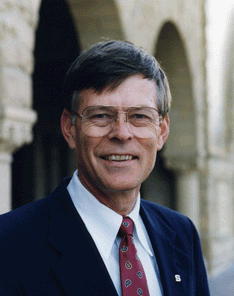Robert L. Byer: Difference between revisions
No edit summary |
N.w.brewer (talk | contribs) No edit summary |
||
| Line 1: | Line 1: | ||
== Biography == | == Biography == | ||
[[Image:Byer Richard.gif|thumb|right]] | |||
Considered by many of his peers as a “pathfinder” in the fields of nonlinear optics and solid-state [[Laser|lasers]], Robert L. Byer’s research and inventions have led to widespread applications of lasers in areas ranging from space science to electronics manufacturing. | Considered by many of his peers as a “pathfinder” in the fields of nonlinear optics and solid-state [[Laser|lasers]], Robert L. Byer’s research and inventions have led to widespread applications of lasers in areas ranging from space science to electronics manufacturing. | ||
Revision as of 19:37, 27 September 2011
Biography
Considered by many of his peers as a “pathfinder” in the fields of nonlinear optics and solid-state lasers, Robert L. Byer’s research and inventions have led to widespread applications of lasers in areas ranging from space science to electronics manufacturing.
Working with lasers at Stanford University, Stanford, California, USA, since 1969, his lab developed the first tunable visible color laser source, ultraviolet solid-state lasers needed for drilling very small holes in circuit boards of electronic components, and laser diode pumped monolithic ring Nd: YAG laser, which is known as the nonplanar ring oscillator (NPRO). The NPRO laser is still being manufactured today, and is used for satellite-to-satellite communications, installed in submarines for sensitive sonar applications, and in space research.
He is currently the William R. Kenan, Jr. Professor of Applied Physics at Stanford University. An IEEE Fellow, he has written more than 500 scientific papers and holds 50 patents in this field. Dr. Byer has previously received the IEEE Quantum Electronics Award and the Optical Society of America R.W. Wood Prize.
